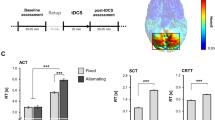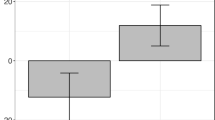Abstract
Recent research in cerebellar cognitive and linguistic functions makes plausible the idea that the cerebellum is involved in processing temporally contiguous linguistic input. In order to assess this hypothesis, a simple lexical decision task was constructed to study whether the effect of transcranial magnetic stimulation on two different cerebellar sites would have a selective impact on associative as opposed to semantic priming. This is the first experiment applying transcranial magnetic stimulation of the cerebellum to a linguistic task. The results show a selective drop in lexical decision accuracy after stimulation of a medial cerebellar site in the first session of participation. Most importantly, they also demonstrate a selective increase of associative priming sizes after stimulation of the same site that cannot be attributed to changes in sensorimotor performance or in accuracy rates. The finding is discussed within the context of domain-general associative cerebellar computations.



Similar content being viewed by others
Notes
As the reviewer correctly notes, a limitation in the design was that only unilateral (right) cerebellar stimulation was used, while laterality of limb responses (right-/left-hand index finger) was confounded with lexical decisions (“word”/“nonword” responses). The number of participants did not suffice to introduce further between-subjects variables to address these issues, and a more elaborate study with more experimental conditions would be required. As noted above, though, trials corresponding to “nonword” responses were all filler trials, and the primary focus of the study was on the speed and accuracy in different types of word–word trials. Furthermore, any motor-related disruptions induced by (right) cerebellar stimulation were expected to selectively affect performance in “word” responses, performed by the ipsilateral (right) index finger (see “Discussion” section).
References
Pickering MJ, Garrod S. Do people use language production to make predictions during comprehension? Trends Cogn Sci. 2007;11(3):105–10.
Paulin MG. A Kalman filter theory of the cerebellum. In: Arbib MA, Amari SI, editors. Dynamic interactions in neural networks: models and data. New York: Springer; 1989. p. 239–59.
Wolpert DM, Miall RC, Kawato M. Internal models in the cerebellum. Trends Cogn Sci. 1998;2(9):338–47.
Courchesne E, Allen G. Prediction and preparation, fundamental functions of the cerebellum. Learn Memory. 1997;4(1):1–35.
Bellebaum C, Daum I. Mechanisms of cerebellar involvement in associative learning. Cortex. 2011;47(1):128–36.
Timmann D, Drepper J, Frings M, Maschke M, Richter S, Gerwig M, et al. The human cerebellum contributes to motor, emotional and cognitive associative learning. A review. Cortex. 2010;46:845–57.
Schmahmann JD. The role of the cerebellum in affect and psychosis. J Neurolinguist. 2000;13:189–214.
Argyropoulos GP. Neocerebellar emulation in language processing. In: Alter K, Horne M, Lindgren M, Roll M, von Koss Torkildsen J, editors. Brain talk: discourse with and in the brain. Papers from the first Birgit Rausing Language. Program Conference in Linguistics. Lund: Lund University, Media Tryck; 2009. pp. 193–206.
Hutchison KA. Is semantic priming due to association strength or feature overlap? A microanalytic review. Psychon B Rev. 2003;10(4):785–813.
Thompson-Schill SL, Kurtz KJ, Gabrieli JDE. Effects of semantic and associative relatedness on automatic priming. J Mem Lang. 1998;38:440–58.
Rogers SL, Friedman RB. The underlying mechanisms of semantic memory in Alzheimer’s disease and semantic dementia. Neuropsychologia. 2008;46:12–21.
Thompson RF, Bao S, Chen L, Cipriano BD, Grethe JS, Kim JJ, et al. Associative learning. Int Rev Neurobiol. 1997;41:152–89.
Christian KM, Thompson RF. Long-term storage of an associative memory trace in the cerebellum. Behav Neurosci. 2005;119:526–37.
McCormick DA, Thompson RF. Cerebellum: essential involvement in the classically conditioned eyelid response. Science. 1984;223:296–9.
Daum I, Ackermann H, Schugens MM, Reimold C, Dichgans J, Birbaumer N. The cerebellum and cognitive functions in humans. Behav Neurosci. 1993;107(3):411–19.
Timmann D, Kolb FP, Baier C, Rijntjes M, Mueller SP, Diener HC, et al. Cerebellar activation during classical conditioning of the human flexion reflex: a PET study. Neuroreport. 1996;7:2056–60.
Woodruff-Pak DS, Papka M, Ivry RB. Cerebellar involvement in eyeblink classical conditioning in humans. Neuropsychology. 1996;10:443–58.
Canavan AG, Sprengelmeyer R, Diener HC, Hömberg V. Conditional associative learning is impaired in cerebellar disease in humans. Behav Neurosci. 1994;108:475–85.
Tucker J, Harding AE, Jahanshahi M, Nixon PD, Rushworth M, Quinn NP, et al. Associative learning in patients with cerebellar ataxia. Behav Neurosci. 1996;110:1229–34.
Woodruff-Pak DS, Vogel III RW, Ewers M, Coffey J, Boyko OB, Lemieux SK. MRI-assessed volume of cerebellum correlates with associative learning. Neurobiol Learn Mem. 2001;76:342–57.
Drepper J, Timmann D, Kolb FP, Diener HC. Non- motor associative learning in patients with isolated degenerative cerebellar disease. Brain. 1999;122:87–97.
Timmann D, Drepper J, Maschke M, Kolb FP, Böring D, Thilmann AF, et al. Motor deficits cannot explain impaired cognitive associative learning in cerebellar patients. Neuropsychologia. 2002;40:788–800.
Timmann D, Drepper J, Calabrese S, Bürgerhoff K, Maschke M, Kolb FP, et al. Use of sequence information in associative learning in control subjects and cerebellar patients. Cerebellum. 2004;3:75–82.
Fiez JA, Petersen SE, Cheney MK, Raichle ME. Impaired non-motor learning and error detection associated with cerebellar damage. A single case study. Brain. 1992;115:155–78.
Gebhart AL, Petersen SE, Thach WT. Role of the posterolateral cerebellum in language. Ann NY Acad Sci. 2002;978:318–33.
Leggio MG, Silveri MC, Petrosini L, Molinari M. Phonological grouping is specifically affected in cerebellar patients: a verbal fluency study. J Neurol Neurosurg Psychiatry. 2000;69:102–6.
Ferrucci R, Marceglia S, Vergari M, Cogiamanian F, Mrakic-Sposta S, Mameli F, et al. Cerebellar transcranial direct current stimulation impairs the practice-dependent proficiency increase in working memory. J Cognitive Neurosci. 2008;20(9):1687–97.
Jarvis BG. DirectRT (Version 2008.1.0.11) [Computer software]. New York: Empirisoft Corporation 2008.
Perea M, Rosa E. The effects of associative and semantic priming in the lexical decision task. Psychol Res. 2002;66:180–94.
Forster KI, Davis C. The density constraint on form-priming in the naming task: Interference from a masked prime. J Mem Lang. 1991;30:1–25.
Leech G. 100 million words of English: the British National Corpus. Lang Res. 1992;28(1):1–13.
Ober B. RT and non-RT methodology for semantic priming research with Alzheimer’s Disease patients: a critical review. J Clin Exp Neuropsyc. 2002;24(7):883–911.
Ferrand L, New B. Semantic and associative priming in the mental lexicon. In: Hauppauge BP, editor. Mental lexicon: some words to talk about words. New York: Nova Science; 2003. p. 25–43.
Kiss GR, Armstrong C, Milroy R, Piper J. An associative thesaurus of English and its computer analysis. In: Aitken AJ, Bailey RW, Hamilton-Smith N, editors. The computer and literary studies. Edinburgh: Edinburgh University Press; 1973. p. 153–65.
McEvoy CL, Nelson DL. Category name and instance norms for 106 categories of various sizes. Am J Psychol. 1982;95(4):581–634.
Van Overschelde JP, Rawson KA, Dunlosky J. Category norms: an updated and expanded version of the Battig and Montague (1969) norms. J Mem Lang. 2004;50:289–335.
Pedersen T, Patwardhan S, Michelizzi J. Wordnet::similarity—measuring the relatedness of concepts. AAAI-04 2004: 1024–5.
Miall RC, Christensen LO. The effect of rTMS over the cerebellum in normal human volunteers on peg-board movement performance. Neurosci Lett. 2004;371:185–9.
Oliveri M, Koch G, Torriero S, Caltagirone C. Increased facilitation of the primary motor cortex following 1 Hz repetitive transcranial magnetic stimulation of the contralateral cerebellum in normal humans. Neurosci Lett. 2005;376:188–93.
Koch G, Mori F, Marconi B, Codecà C, Pecchioli C, Salerno S, et al. Changes in intracortical circuits of the human motor cortex following theta burst stimulation of the lateral cerebellum. Clin Neurophysiol. 2008;119:2559–69.
Hashimoto M, Ohtsuka K. Transcranial magnetic stimulation over the posterior cerebellum during visual saccades in man. Brain. 1995;118:1185–93.
Ugawa Y, Uesaka Y, Terao Y, Hanajima R, Kanazawa I. Magnetic stimulation over the cerebellum in humans. Ann Neurol. 1995;37(6):703–13.
Ohtsuka K, Enoki T. Transcranial magnetic stimulation over the posterior cerebellum during smooth pursuit eye movements in man. Brain. 1998;121:429–35.
Larsell O, Jansen J. The comparative anatomy and histology of the cerebellum, vol 3 III: the human cerebellum, cerebellar connections and cerebellar cortex. Minneapolis: University of Minnesota Press; 1972.
Schmahmann JD, Doyon J, McDonald D, Holmes C, Lavoie K, Hurwitz AS, et al. Three-dimensional MRI atlas of the human cerebellum in proportional stereotaxic space. Neuroimage. 1999;10:233–60.
Huang Y, Edwards MJ, Rounis E, Bhatia KP, Rothwell JC. Theta burst stimulation of the human motor cortex. Neuron. 2005;45:201–6.
1Demirtas-Tatlidede A, Freitas C, Cromer JR, Safar L, Ongur D, Stone WS, et al. Safety and proof of principle study of cerebellar vermal theta burst stimulation in refractory schizophrenia. Schizophr Res. 2010;124(1–3):91–100.
Koch G, Brusa L, Carrillo F, Lo Gerfo E, Torriero S, Oliveri M, et al. Cerebellar magnetic stimulation decreases levodopa-induced dyskinesias in Parkinson disease. Neurology. 2009;73:113–9.
Stewart LM, Walsh V, Rothwell JC. Motor and phosphene thresholds: a transcranial magnetic stimulation correlation study. Neuropsychologia. 2001;39(4):415–9.
Devlin JT, Watkins KE. Stimulating language: insights from TMS. Brain. 2007;130(3):610–22.
Del Olmo MF, Cheeran B, Koch G, Rothwell JC. Role of the cerebellum in externally paced rhythmic finger movements. J Neurophysiol. 2007;98:145–52.
Torriero S, Oliveri M, Koch G, Lo Gerfo E, Salerno S, Petrosini L, et al. Cortical networks of procedural learning: evidence from cerebellar damage. Neuropsychologia. 2007;45(6):1208–14.
Perea M, Gotor A. Associative and semantic priming effects occur at very short stimulus-onset asynchronies in lexical decision and naming. Cognition. 1997;62:223–40.
Moretti R, Bava A, Torre P, Antonello RM, Cazzato G. Reading errors in patients with cerebellar vermis lesions. J Neurol. 2002;249(4):1432–59.
Ilg UJ, Thier P. The neural basis of smooth pursuit eye movements in the rhesus monkey brain. Brain Cogn. 2008;68(3):229–40.
Nagel M, Zangemeister WH. The effect of transcranial magnetic stimulation over the cerebellum on the synkinesis of coordinated eye and head movements. J Neurol Sci. 2003;213:35–45.
Leggio MG, Chiricozzi FR, Clausi S, Tedesco AM, Molinari M. The neuropsychological profile of cerebellar damage: the sequencing hypothesis. Cortex. 2011;47(1):137–44.
Okugawa G, Sedvall GC, Agartz I. Smaller cerebellar vermis but not hemisphere volumes in patients with chronic schizophrenia. Am J Psychiat. 2003;160:1614–7.
Okugawa G, Nobuhara K, Takase K, Kinoshita T. Cerebellar posterior superior vermis and cognitive cluster scores in drug-naïve patients with first-episode schizophrenia. Neuropsychobiology. 2007;56:216–9.
Picard H, Amado I, Mouchet-Mages S, Olié J-P, Krebs M-O. The role of the cerebellum in schizophrenia: an update of clinical, cognitive, and functional evidences. Schizophrenia Bull. 2008;34(1):155–72.
Nestor P, Valdman O, Niznikiewicz M, Spencer K, McCarley R, Shenton M. Word priming in schizophrenia: associational and semantic influences. Schizophr Res. 2006;82(2):139–42.
Schmahmann JD. Dysmetria of thought: clinical consequences of cerebellar dysfunction on cognition and affect. Trends Cogn Sci. 1998;2(9):362–71.
Miall RC, King D. State estimation in the cerebellum. Cerebellum. 2008;7:572–6.
Théoret H, Haque J, Pascual-Leone A. Increased variability of paced finger tapping accuracy following repetitive magnetic stimulation of the cerebellum in humans. Neurosci Lett. 2001;306:29–32.
Acknowledgments
GPA would like to warmly thank Dr. Neil Muggleton for subject recruitment and technical support, Dr. Gorana Pobric for earlier pilot tests, Dr. Patrick Sturt, Prof. Jim Hurford, and Dr. Thomas Bak for helpful comments, the reviewer of the journal for their precious feedback, and the ‘Pavlos and Elissavet Papagiannopoulou Foundation’ for the financial support.
Conflict of Interest
There were no conflicts of interest.
Author information
Authors and Affiliations
Corresponding author
Rights and permissions
About this article
Cite this article
Argyropoulos, G.P. Cerebellar Theta-Burst Stimulation Selectively Enhances Lexical Associative Priming. Cerebellum 10, 540–550 (2011). https://doi.org/10.1007/s12311-011-0269-y
Published:
Issue Date:
DOI: https://doi.org/10.1007/s12311-011-0269-y




